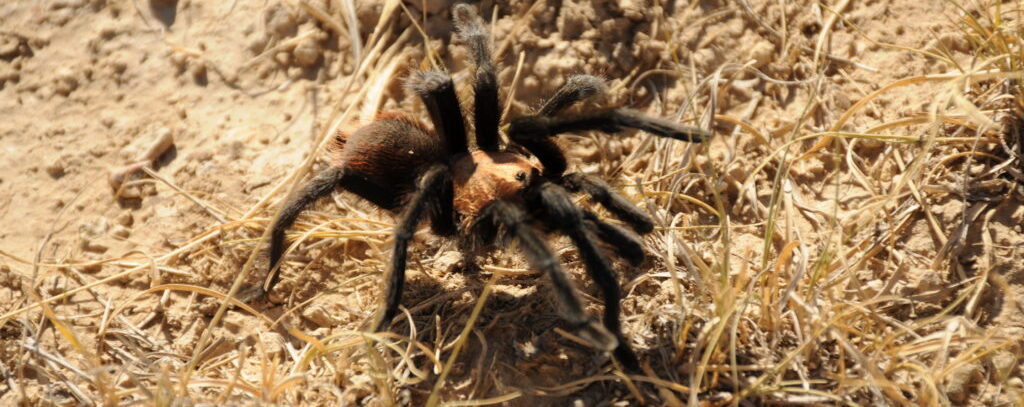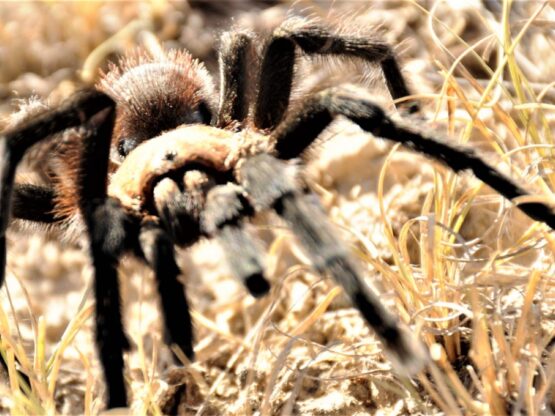Tarantula Trek
A Mating Expedition

Each fall, large numbers of tarantulas skitter across the landscape in La Junta and southeast Colorado. Yes, tarantulas!
While this phenomenon has traditionally been called a migration, it is actually an annual mating ritual performed by male tarantulas who roam across the 443,000-plus acres on the Comanche National Grassland - the 4th largest grassland in the nation - looking to mate.
While there are numerous species of tarantulas, you are likely to spot the 'Colorado' Brown Tarantula in La Junta.
This dark brown to black species of the genus Aphonopelma is common here because its females prefer to make their burrows in the plentiful undisturbed prairies on the Comanche National Grassland of Southeast Colorado. Once these females have made their burrows, they tend to stick close to them for the entirety of their lives, which can be 25 years long.
Whether you have a few hours, a few days, or a few weeks, explore a few of the suggested travel ideas and itineraries of things to do in La Junta.
Viewing Tips
The best time to view tarantulas is an hour before dusk during mid-September thru October and even into early November—depending on the weather. Because these spiders prefer undisturbed lands to nest, the vast and beautiful prairies on the Comanche National Grassland make ideal habitats.
You generally will not find tarantulas where people have plowed. They have permanent burrows, which they may inhabit for two decades. During the day, the burrow entrance is often marked with a veil of silk to deter predators, so it has to be an area that hasn’t been destroyed. It has to be a relatively intact, native prairie.
If you have seen headlines about “thousands of tarantulas” or “waves of tarantulas” marching across southeast Colorado every fall, you might have the wrong idea. On the contrary, you might see one, two, or ten crawl across the prairie at a time. Or, you might see none.
- September is the ideal time of year to view the tarantulas - there may still be activity in October and November.
- The ideal viewing time is in the hour before sunset, venture out around 5:45 pm to 6:00 pm. Peak viewing lasts about an hour.
- Some tarantulas may be active in the late afternoon.
- Respect private property boundaries! Pay attention to signs, fences and closed gates as indicators of private land.
- Scout areas where there are tarantula hawks—the spider hunting wasps that prey on tarantulas.
- Be aware of cars and trucks traveling the road at all times.
- Venture out on a day that is warm, and preferably not too windy.
- An ideal viewing location is south of La Junta on Highway 109 on the Comanche National Grassland.
- While tarantulas may be harmless, stopping on the road can be anything but.
responsible & respectful tarantula viewing
Plan Ahead for Safe Viewing
Tarantulas aren’t dangerous to humans. Stopping on the road is!
Encountering tarantulas on the highway can be an intriguing experience, with safety always remaining a top priority. To ensure a safe and enjoyable viewing experience, plan your route ahead of time so you know where to find safe areas for parking and viewing. If you must pull off the road, be sure to do so in an area where there's ample space for passing vehicles, and keep an eye out for rattlesnakes which are common this time of year. While tarantulas themselves pose no threat to humans, stopping abruptly on the road can lead to dangerous situations for motorists, viewers, and the spiders themselves. By avoiding sudden stops and maintaining awareness of traffic flow, we can appreciate these fascinating creatures without putting ourselves or others at risk. Let's remember that while tarantulas may be harmless, stopping on the road can be anything but.
Respect Private Property
Tarantulas Only Beyond This Point.
As you embark on your tarantula viewing journey amidst the breathtaking scenery of the Comanche National Grassland, it's important to keep in mind the value of respecting private property boundaries. In rural Colorado, where open grazing is common, it's a best practice to pay attention to signs, fences, and closed gates as indicators of private land. Crossing these boundaries without permission not only compromises property rights but also impacts the harmony of rural life. Let's show our appreciation for the tarantulas and their habitats while also respecting our neighbors and the unique southeastern Colorado lifestyle.
View With Care
Tarantula love is tough love. Let’s not make it tougher.
When observing tarantulas on their mating expedition, it's important to approach with respect and appreciation for these fascinating creatures. While it might be tempting to aim for them or try to capture them for closer inspection, it's best to let them be in their natural habitat. Tarantulas won't attack your tires, leap into your vehicle, or become unwanted guests at home. Feel free to snap photos from a distance, but remember to give them space to roam freely. Although tarantulas can bite if provoked, their venom is harmless to humans, akin to a bee sting. However, their protective hairs may cause itching, so it's best to admire them without direct contact. Additionally, handling them can pose risks, as they can be injured if they fall from a height, even from as high as your hands. Let's enjoy the wonder of tarantulas while ensuring their well-being and our own safety.
Protect Our Habitat and Heritage
Tarantulas are only part of the story.
While enjoying the sight of tarantulas moving across the landscape, let's acknowledge that we are visitors in a place steeped in history and significance. Remember, we are the guardians of the canyons of the Comanche National Grassland, the 4th largest grassland in the country, where precious artifacts offer glimpses into the thriving civilizations that once called this area home. Each relic holds a clue that archaeologists use to reconstruct life here long ago, making these cultural resources ancient, fragile, and irreplaceable. Touching rock art, for example, can promote deterioration of the drawings and the rock surface due to oils from your hands. Furthermore, drawing or scratching graffiti on rocks or cliff faces defaces a fragile, irreplaceable legacy. When traveling through the Comanche National Grassland, be sure to stay on designated roadways so as not to disturb the fragile soil or risk getting stuck. The Comanche National Grassland not only provides essential habitats for a variety of wildlife, including tarantulas, but also holds invaluable cultural treasures. As stewards of this land, it's our duty to tread lightly, preserving the delicate balance of the ecosystem and honoring the legacy of those who came before us.
Be Tarantula Expedition Ready
How to prepare for a Tarantula Trek.
Before setting out on your tarantula viewing adventure, it's essential to prepare thoroughly for a safe and enjoyable experience. Start by checking the weather forecast and road conditions to ensure smooth travels. Pack an ample supply of water and snacks to stay hydrated and energized throughout the expedition. Don't forget to equip your vehicle with essentials like a spare tire and emergency supplies for any unforeseen circumstances. Since cell service can be unreliable in remote areas, download maps and identify parking areas in advance. Dress in layers to accommodate potential weather changes, and opt for sturdy, closed-toed shoes for comfort and protection. During this time of year, various hunting seasons are in progress. While hunters are typically safety-conscious, it's advisable not to wear tan and white, the colors of pronghorn, to avoid confusion. Additionally, if you plan to be near roadways, wearing an orange vest is recommended to increase visibility to hunters and other drivers. Before hitting the road, stop in La Junta to gather tarantula viewing information from our local shops, restaurants, gas stations, and hotels. Additionally, stay updated on the latest news and safety tips by checking our website, Facebook, and Instagram channels. With proper preparation and awareness, you can make the most of your tarantula viewing experience while ensuring a safe and memorable journey.
Where to find tarantulas
Take a Drive
Ideal places to look for those males are south of La Junta on Highways 10, 350, and 109, and county roads in between, an hour or so before sunset. Comanche National Grassland is a good place to spot them as well.
Popular sites include Vogel Canyon (15 miles from La Junta), Sierra Vista & Timpas Picnic Area (about 20 miles from La Junta along Hwy 350), and Delhi (36 miles from La Junta on Hwy 350).
Vogel Canyon is a short drive from La Junta and is always a popular destination because it has something for everyone—from short hikes to quiet picnics. Vogel Canyon Picnic Area has picnic shelters, a vault toilet, and hiking trails with a variety of difficulties and lengths that take you to the mesa top or canyon bottom.
A great driving route to consider is La Junta to Timpas (on HWY 350), east on County Road N, south on County Road 25, east on Forest Service Road 2200, north on HWY 109, and then back to La Junta.
Contact the Comanche National Grassland Resource Office for additional ideal viewing locations in and around La Junta at (719) 384-2181 or info@visitlajunta.net for additional information.
tarantula viewing opportunities
sierra vista
For Santa Fe Trail travelers heading southwest, the route along Timpas Creek marked a major milestone in their journey. Leaving the Plains and entering the foothills and mountains, travelers were guided by the distant Spanish Peaks, which came into view along this section of the Trail. A short walk to the top of a low bluff gives visitors a commanding view of the Southern Rocky Mountains and surrounding prairie, much like that afforded early travelers. A 3.7-mile hiking trail follows ruts of the Santa Fe Trail between Sierra Vista Overlook and Timpas Picnic Area.
TIMPAS
Tucked away near La Junta, Timpas has few homes and several abandoned buildings. The unincorporated community sits at 4,430 feet. There was a post office that ran from 1891 to 1970. Now the La Junta Post Office serves Timpas. Timpas Creek was the first source of water for Santa Fe Trail travelers after leaving the Arkansas River heading southwest and became an important stop for thirsty travelers and stock. Today, Timpas Picnic Area is located near Timpas Creek. Facilities include two covered picnic shelters, one group site with four covered picnic tables and grills, one vault toilet, and two hiking trails.
Vogel Canyon
Vogel Canyon is a short drive from La Junta and is always a popular destination because it has something for everyone, including short hikes and quiet picnic spots. Vogel Canyon is a scenic tributary of the Purgatorie River. Permanent springs at the bottom of the canyon support a variety of wildlife, which can best be seen early in the morning or just before sunset. Vogel Canyon has a rich history. American Indians lived in the canyon 300-800 years ago and left rock art which is visible on the canyon walls. Vogel Canyon Picnic Area has three picnic shelters, a vault toilet, and four hiking trails with a variety of difficulties and lengths that take you to the mesa top or canyon bottom. Directions: From La Junta, drive south on Highway 109 for 13 miles. Turn right (west) on County Road 802 for 1.5 miles. Turn left (south) on Forest Service Road 2200 for 1.5 miles to the Vogel Canyon parking lot.
iron spring
Iron Spring was an important water stop for travelers on the Santa Fe National Historic Trail. Depending on the season or weather conditions, several different routes to the spring were used. Between 1861 and 1871, Iron Spring was also used as a stagecoach station. Trail ruts are still visible just west of the parking lot. Directions: From La Junta drive southwest on Highway 350 for 27 miles. Turn left (south) at County Road 9 for 1 mile and then turn right (west) to the parking lot.
picketwire corrals interpretive site (poi on tarantula quest)
This popular meeting spot, about 33 miles south of La Junta, offers wildlife interpretation and corrals for public equestrian use.
withers trailhead (poi on tarantula quest)
This is the starting point for the Picket Wire Trail, which descends 250 feet into the Picket Wire Canyonlands and continues 8.5 miles one way along the Purgatoire River Valley bottom to Rourke Ranch National Historic District. Not interested in a long hike? Follow the one-mile Withers Loop Trail from the trailhead to the rim of Picket Wire Canyonlands and enjoy some spectacular views! This is the only public access to Picket Wire Canyonlands. Hiking, non-motorized bicycles, and horseback riding are permitted. Directions: From La Junta, drive south on Highway 109 for 13 miles; turn right (west) on County Road 802 (David Canyon Road) and continue for 8 miles. Turn left (south) on County Road 25 and travel for 6 miles. Turn left at Picket Wire Corrals onto Forest Service Road 2185. Travel along Forest Service Road 2185 for 3 miles, following the signs to Withers Canyon Trailhead. Park at Withers Canyon Trailhead parking loop.
dolores mission and cemetery (poi on tarantula quest)
After the territory south of the Arkansas River became part of the United States in 1846, many people from Mexico migrated north to settle. A group of eleven families, led by Damacio Lopez, settled in Picket Wire Canyonlands in 1871 and established the first permanent settlement in the Canyonlands. This predominantly Catholic community did not have a local church or priest to practice their religion. However, in 1898, Damacio sold 0.11-acres of his land to the Denver Diocese for $1.00. The community then built a church called the Dolores Mission.
dinosaur track (poi on tarantula quest)
Along the Purgatory River tracks from dinosaurs such as Apatosaurus (brontosaurus), stegosaurus and Allosaurus are found. The area has come under serious scientific investigation in recent years. But it wasn’t always that way, in fact, the dinosaur tracks were a well-guarded secret until letters in Life Magazine and Scientific American in 1935 reported the existence of dinosaur trackways in the Purgatory Valley.
rourke ranch historic district (poi on tarantula quest)
Rourke Ranch played a significant role in the settlement and agricultural development of the Purgatoire River area and continues to reflect the interaction of its Hispanic and Anglo-American settlers. Beginning in the early 1870s, Eugene and wife Mary began acquiring the lands of departing Hispanic farmers and sheep growers, eventually amassing one of the largest cattle ranches in the area.
Tarantula Safety
While we love to invite visitors to see the tarantulas in and around La Junta, we ask that you do the tarantulas right by viewing them with care and following these guidelines.
- Do not enter or park on private land for tarantula viewing. Make sure you remain on public land and public roads.
- To be safe, if you see a tarantula, pull as far off the roadway as possible or find a turnout or intersection (note that most of these highways don’t have shoulders).
- Tarantulas may be seen skittering across highways. Please do not stop in the middle of the road to view the tarantulas. It is important to follow all traffic rules and pull over in a safe viewing area where there is ample room for cars to continue on the highway.
- Do not come to an abrupt stop or leave your vehicle in the middle of the road because other watchers may be more focused on the spiders than other vehicles.
- Do not block other roadways.
- Once you have exited your vehicle, it goes without saying to watch both ways for traffic before pursuing a tarantula. Also, make sure you’re on public, not private property.
- There are various hunting seasons going on during this time of year. Even though most hunters are very safety conscious, it is best not to wear tan and white (the colors of pronghorn).
- Actually, if you are going to be along roadways, wearing an orange vest is probably a very good idea, so that other drivers can spot you better.
- Please do not aim for the tarantulas and smash them on the highway. They will not attack your tires, jump into your vehicle, or follow you home.
- Take photos if you would like, but let the tarantulas be. Although tarantulas can bite, their venom is not toxic to humans and is comparable to a bee sting. The hairs on their bodies can result in itching, though. They can be hurt if they fall from a distance, such as your hands.
- Be aware of passing traffic while outside of your vehicle. And be sure to keep an eye on any children.
- Please remember that you are the guardian of the unique canyons on the Comanche National Grassland. Rock art, stone tools, charred bones, and rubble from dwellings provide evidence that people thrived on the Comanche National Grassland for thousands of years. Each relic of the past holds a clue that archaeologists use to reconstruct life here long ago. These cultural resources are ancient, fragile, and irreplaceable. If destroyed or removed, the information they reveal is lost forever. And so is a legacy that belongs to us all.
- When on the Comanche National Grassland, please do not touch rock art! Oils from your hands promote deterioration of the drawings and the rock surface. Do not draw or scratch graffiti on rocks or cliff faces. Graffiti defaces a fragile, irreplaceable legacy.
CARE FOR COLORADO… AND TARANTULAS!
Care for Colorado promotes the following principles:
- Know Before You Go
- Stick To Trails
- Leave It As You Find It
- Trash the Trash
- Be Careful With Fire
- Keep Wildlife Wild
- Share Our Parks & Trails
We kindly ask that you practice these while looking for tarantulas. Respect them and their home by Caring for Colorado.

ABOUT THE TARANTULA TREK: A MATING EXPEDITION

While you might have heard of the “tarantula migration,” it is not a migration at all. Rather, it is male tarantulas seeking out a mate, which they start doing when they reach maturity at the age of eight to 10 years old.
Prior to this age, these boys have not left the grassland in southeast Colorado at all but have simply been buying their time until they reach mating age. And though you are likely to spot one at a time, you may be lucky enough to see a group of these males who use their sense of touch and vibration to locate the females.
For the Oklahoma Brown Tarantula, males tend to seek out females from September through October.
Tarantulas are very large, hairy spiders that can be found in the southwestern United States, including southern Colorado. All species found in this area are generally dark brown to black. The tarantula can attain a body length of up to 2 inches and a leg span of up to 5 inches.
Males reach maturity about 7-10 years after egg hatch. They can travel as many as twenty miles and oftentimes are in groups searching for a mature female. Once fertilization has occurred, the female constructs a huge (golf ball-sized) egg sac, to lay her eggs in. She then protects the egg sac from predators and turns it frequently. Hundreds of spiderlings can hatch at a time. Almost all tarantulas that are observed are mature males seeking a mate. Tarantula mating is probably one of the strangest animal reproduction rituals. It is unlike anything else we have seen in the animal realm, and it functions in a completely different way thanks to tarantulas' unusual bodies.
Males who have reached sexual maturity will usually go through an "ultimate" or final molt and "hook out," which means they will have their tibial hooks as well as bulbs at the end of their pedipalps. This is a physical marker of sexual maturity. Therefore, many won't be surprised to find this male tarantula constructing a sperm web in preparation for mating.
At this time, a male tarantula can travel up to a mile to find a mate, and once he finds one, he’ll perform a courtship dance. Certain body language cues and rituals exist, just as they do in many other animals. One of these is "drumming" or "tapping," which a tarantula may use to indicate interest in a potential spouse. For example, a male tarantula may tap his pedipalps or legs on a female's web in a courting setting to determine whether she is interested and alert her to his presence and intent. If she's receptive, she might return the drumming as a signal for him to approach.

Unfortunately, males typically don’t live long after mating. Death by predator, car, or starvation—or rather, lack of interest in eating anything—typically follows. And in some cases, the female may eat the male.
Females, on the other hand, may live for more than two decades, and they rarely leave the vicinity of their burrows. Females are larger than the males and reach maturity between 8 to 10 years. It is not uncommon for females to live over 20 years. However, males rarely live one year past maturity and usually die during or shortly after mating because they are killed by vehicles while crossing the roads or become the victim of predators like tarantula hawk wasps, coyotes, or even female tarantulas.
Tarantula hawks, the spider hunting wasp, prey on tarantulas. These huge wasps (the largest wasps in the United States) feed on nectar but reproduce in a particularly morbid fashion. When a female wasp is ready to lay her eggs, she seeks out a tarantula and injects it with paralyzing venom. She drags the tarantula to a burrow, stuffs it down the hole, then lays her eggs on top of the paralyzed spider. Several days later, the eggs hatch, and the larvae feed on the still-living tarantula.
ANNUAL LA JUNTA TARANTULA FEST
Join us for the Annual La Junta Tarantula Fest in Downtown La Junta, the last Friday and Saturday in September. Enjoy a parade, vendors, live art, education pavilion, tarantula tours and much more!
FAQS
Will the tarantulas hurt me?
This specific group of tarantulas is completely docile. They’re not looking to harm humans. However, it’s best not to touch or try to pick up a tarantula. Rather, we ask everyone to keep a safe distance, allowing the tarantulas to be undisturbed and in their natural habitat. Despite their large size, tarantulas pose little hazard to humans. We suggest that you do not harass the spiders by handling them or disturbing their nesting hole. Simply enjoy observing and photographing the tarantulas as they make their annual trek in search of a female.
what type of tarantulas are these?
Aphonopelma hentzi, aka Oklahoma Brown, or as our researchers have named them, the 'Colorado Brown.'
what's the difference between male and female tarantulas?
The on-the-move tarantulas—the males—are longer, with a small abdomen and long, spindly legs to help them get around quickly. The females, on the other hand, don’t need that kind of biological adaptation and are often larger.
can tarantulas hurt me?
Tarantulas are much more terrified of you than you are of them. Despite common misconceptions, they are not aggressive animals and will not jump or attack a person. In fact, they are more likely to flee from a larger-than-life human being.
But leave them be - don't pick them up - and you won't have to find out!
Farm Markets
Do not forget to stop by one of the many Farm Markets along Highway 50 when you come to view the tarantulas! Arkansas Valley farmers work hard on their farms all season to grow a wide variety of produce, such as corn, watermelons, cantaloupes, and much more.
Farm Markets are typically open between July and October to the delight of residents and visitors alike seeking the good bounty from this fertile land.
Tarantula Press
follow us on instagram










